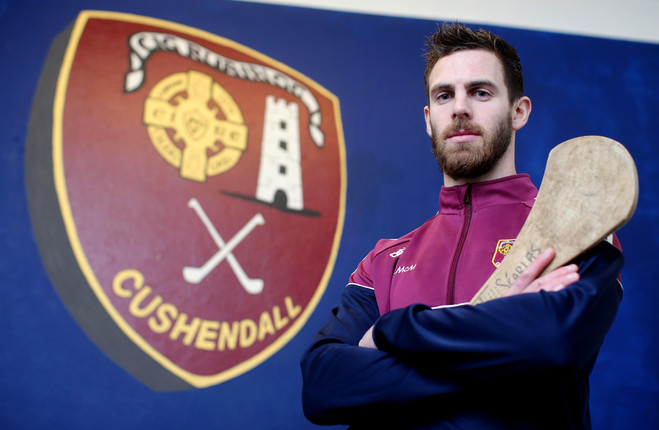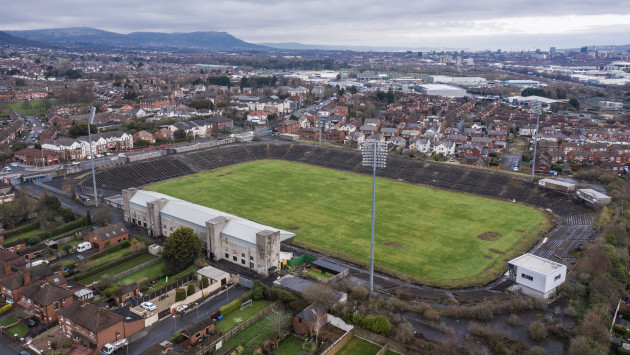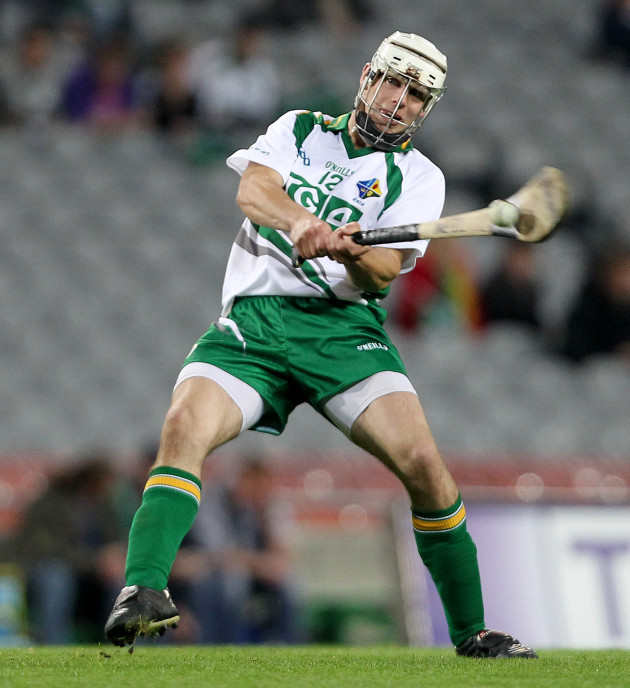IT’S BEEN ONE of those weeks in the life of Neil McManus when it just keeps giving.
On Sunday, he makes it a Baker’s Dozen of Antrim county hurling finals when Ruairí Óg Cushendall head to Corrigan Park to take on Loughgiel Shamrocks, who sensationally brought Dunloy’s five-in-a-row bid to a shuddering halt in the semi-final.
To date, he has won six of his twelve final appearances and lost out on the 2011 final through injury, when they lost to this weekend’s opponents.
On Wednesday, confirmation was delivered that Casement Park would be rebuilt in time for the hosting of the Euro 2028 Tournament.
And towards the end of the month, he gets to captain his country when Ireland take on Scotland in Newry on 21 October in a Shinty/Hurling compromise rules game.
Given his evangelism for hurling, for the Casement Park project, add in his fervent pride and his interest in hurling culture – one that has him out at the weekends with his friend Terence ‘Sambo’ McNaughton bringing tourists on a tour called ‘Hurling In The Glens’ – it’s a significant spell for him.
First things first; the county final. Cushendall haven’t won the Volunteer Cup since 2018. Loughgiel, All-Ireland winners in 1983 and 2012, haven’t been there since 2016.
But Loughgiel blew the race wide open a fortnight ago when they beat Dunloy – going for five-in-a-row and All-Ireland finalists last January – 1-21 to 0-13 in the semi-final.
“The Antrim county final is a brilliant event, it has almost a festival feel to it and it is a huge day in the Ulster GAA calendar,” McManus says.
“I have been lucky to play in a number of county finals and the standard of the game, the standard of the clubs who reach them is on a par with anything in Ireland and exceeds most other counties in truth.
“The case in point was Dunloy pushing the current All-Ireland champions all the way in January’s All-Ireland final.”
He’s been as used to winning county finals as he is to losing them, an illustration of how intensely fought they are.
“I think that the finals we left behind, I think every player who has played in as many finals as I have at club level would feel there are finals we could and should have won,” McManus states.
“But at the same time, I think you get what you deserve. I think when we have been at our best, we have won county finals.
“Whenever we weren’t at our best, we didn’t reach them. For a couple of years we were going through a period of transition and weren’t holding ourselves to standards we would pride ourselves on and we paid the price for it because we were getting beaten in quarter-finals and semi-finals.”
The final will be played in Corrigan Park, the de facto Antrim stadium over the past few seasons while Casement Park a few miles down the road lies in derelict mess.
Political manoeuvring and petty tactics has kept the development of the Andersonstown Road venue closed since 2013. In that time, political parties have seldom let up in their back-clapping about finally getting the project over the line.
In truth, it’s only with the advent of a major soccer tournament that the funding will be sourced. Even at that, members of the DUP have promised to veto the progress, an impotent claim given they have taken themselves out of the Stormont executive since their disastrous election result in May of 2022.
McManus has strong links with west Belfast and is delighted with recent developments. In recent weeks he attended a 70th anniversary function for Casement Park in St Mary’s College.
“We were taken through all the hard work that it had taken to bring Casement to fruition and then obviously it was taken over by the British army during the Troubles and had to be re-opened and a lot of work done to make it usable and functional afterwards,” he explained.
“It’s been through the mill. A lot of people in my father’s generation were even schooled within the building. It was used as a primary school too so there’s a huge amount of history, a place very dear to our hearts.
“I think anybody involved in sport and not just ourselves, are just happy that we’re getting the GAA stadium that we were promised at the start of this process about a decade ago.”
McManus played his first few games for Antrim back in 2007 and featured in one memorable evening in that debut season when a rescheduled league game against Dublin took place under the floodlights.
By the time Casement was handed over for redevelopment, he already had seven seasons of calling it home. As he notes, an entire generation of Antrim hurler will come and go with over a decade of service and never get to play there.
“On the panel at the minute, only Ciarán Clarke and Conor McCann have played senior hurling for Antrim there. They won’t be around in 2027 so a full generation of Antrim players won’t have played there so it’s a travesty,” he points out.
He’s not too impressed with the lack of political skill that has taken it so long to be realised.
“If you’re au fait with politics in the North, you won’t be surprised that this has been used as a political football and the project fell victim to poor leadership from Stormont,” he says.
“In fact, rarely could you say that something has been a net positive of the Executive not being up and running, because the British and Irish governments have made this decision together and I don’t think there’d be any games were it not for the Euros and the need to get Casement off the ground.”
Should Ruairí Ógs add to their 16 county titles, then he might be facing a clash of commitments, but he looks forward to the second time he gets to captain Ireland in the Shinty/Hurling International.
“It is actually the second time I have had the chance to captain the ship, which is great because we don’t have any other vehicle as hurlers to play for Ireland and to represent our nation so it is a really nice honour to have,” McManus says.
“I suppose the compromise rules is a much higher profile event but the Shinty is a brilliant event in that the Scots are so similar to ourselves, those Celtic connections are very similar and we share an awful lot.
“Even our Ulster Gaelic is very similar to Scottish Gaelic and when you are in the Glens of Antrim there is only a very small stretch of water separating ourselves and the Western Isles of Scotland and Mull of Kintyre.”
So far, the team have had five weekend sessions in preparations for their Celtic cousins. Having featured before, one thing that impresses him about the Scots is their ability to switch the play from wing to wing, with players on the other side of the pitch instinctively knowing the tactic.
Apart from that, the only other thing to remember is to bring the shinpads. Getting a skelp from a shinty stick is far from pleasurable.
“I was describing it earlier as hurling a la 1970s, so it’s a little bit like that where you can let the stick go a little bit,” he laughs.





